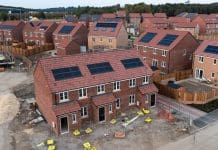The shortage of properties in the UK is a significant problem. Tom Shaw, Director at Ramboll addresses some of the measures that could help tackle the growing housing crisis
It is well known that the UK is in the midst of a housing crisis; it simply does not have enough homes. In London alone the population is growing by about 100,000 annually, but last year only 25,000 homes were built in the same period. Many have sought to provide a feasible solution to this with various suggestions including the maximisation of construction on city brownfield sites. However as well as finding the land to build on, we also need to find solutions that enable rapid construction on a much larger scale. The recent government commissioned review by Mark Farmer, “Modernise or Die”, has highlighted the construction industry must take radical steps to avoid “inexorable decline”.
Construction sector suffers a lack of innovation
The Farmer Review emphasised, that unlike other industries that have constantly improved with time, construction has plateaued for decades. There has been a lack of collaboration and innovation, with labour shortages causing cost inflation as more leave the industry than join. The report may be difficult reading, with controversial recommendations such as a “carrier-bag tax” for developers, but the only way we can resolve the housing crisis is by overcoming these issues.
Crucially we must encourage developing new technologies to flourish amongst more traditional construction techniques, open up supply chains and increase market capacity. It is important to note that this is not a matter of replacing well established traditional forms of construction, but increasing construction volumes through supplementing existing methods. Offsite construction is key in ensuring high quality and consistent finishes, minimising labour on site. Construction workforces are reducing, as those wanting to work on construction sites wanes, and factories offer new centres of employment without the need for workers to travel long distances to work on site.
Three methods to address the housing crisis
In looking to explore how engineers are addressing this problem now, we believe there are three clever modern methods of engineering already leading the way.
Cross-Laminated Timber: Compared to traditional counterparts CLT is much more time efficient and lighter in weight, making it ideal for constrained inner city sites where there are often weight restrictions (such as over railway tunnels). A greater number of apartments can be built rapidly within the same space. Complications regarding fire, longevity, mortgages, insurance and availability have been overcome and thankfully we are starting to see more CLT buildings constructed, especially in London. Hackney’s ‘timber first’ policy is a testament to the confidence now held in this versatile and dynamic material. Dalston Lane, a 121 unit residential development is one of the latest to be in constructed in the borough.
Precast concrete: Due to poor quality control in the 50’s and 60’s this method became unpopular, however nowadays precast construction provides both advanced finishes and significant time-saving. Precasting consists of pouring concrete into a reusable mould in a factory, before transporting these elements to site where they are lifted and fixed into place. The luxury Merano tower in Vauxhall is an excellent example of this, allowing construction of an extremely constrained site the size of two tennis courts.
Prefabricated volumetric pods: This offers an entirely new approach to construction, whereby full rooms or apartments are manufactured in a factory environment. The whole unit is then transported and stacked on site by cranes, saving both overall project time and time spent on site. It has been successfully utilised by hotels and student housing projects, and more recently has become popular for more typical residential housing projects, such as the Pocket Living development recently completed in Streatham.
So could these methods solve the housing crisis?
Simply pumping in more resource is not enough and may not be possible; the industry must innovate and embrace new ways of building. These modern twists on more traditional forms of construction allow building on a larger, taller, quicker and more economical scale, while still remaining affordable – all of which are crucial if we are to meet the ever growing housing demands of our cities.
 Tom Shaw
Tom Shaw
Director
Ramboll
https://twitter.com/ramboll_uk














